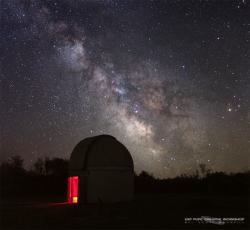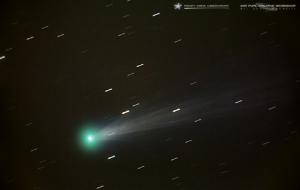
Public Stargazing
- Where:
- Frosty Drew Observatory
- When:
- Friday August 22, 2014 at 7:00 p.m.
- Cost:
- $1 Suggested Donation per Person
Tonight's forecast is calling for partly cloudy to mostly cloudy skies for most of our stargazing times. This is rather unfortunate since the 8% waning crescent Moon does not rise until 3:27 a.m. and would have left the skies super dark for stunning views of the Charlestown starscape. Since the forecast is somewhat variable, we will take the night as it goes. We will cancel solar viewing this afternoon and plan to open at 7:00 p.m. in the Sky Theatre with a slide show presentation of objects we photograph at Frosty Drew Observatory. At 8:00 p.m. we will open a telescope and monitor the skies for viewing opportunities posting updates to @FrostyDrew on Twitter and our Facebook (http://www.facebook.com/FrostyDrewObservatory). If the skies are acceptable, Saturn will be our primary target with star clusters, nebulae, and possibly Comet Jacques on our list. Keep up with @FrostyDrew on Twitter (http://twitter.com/FrostyDrewOBSY) to make an informed decision before trekking out tonight.
-------------------------------------------------------------------------
Weekly Happenings
Scott MacNeill
On March 13th 2014, while searching for Near Earth Asteroids (NEA's), Cristovao Jacques of SONEAR discovered a new comet that would potentially become one of the brighter comets of 2014. The comet, named C/2014 E2 Jacques, originating in the Oort Cloud (the cosmographical boundary of the solar system), has a super long solar orbital period of 20,000 years. Compared to Earth's 1 year orbit around the Sun, Comet Jacques takes 20,000 years to orbit our nearest star! On July 3rd, Comet Jacques made its closest approach to the Sun, called “perihelion”, at a balmy 61.7 million miles. Since then Jacques has been heading back out of the solar system and will pass at its closest point to Earth this Thursday, August 28th, at 52.4 million miles distant. Since perihelion, Comet Jacques has grown a bright coma (the atmosphere around a comet's nucleus created by out gassing of the comet) and a slender tail. The brightening of Comet Jacques places it around visible magnitude 7, which is within the reach of 10x50 binocular visibility. The problem for us Northern Hemisphere observers has been the position of the comet. Hanging out in the constellations Taurus and Auriga has kept the comet on the horizon into the pre-dawn sky. As Comet Jacques approaches Earth, it has been rising higher into the night sky becoming visible earlier each night, though this increased visibility has been met with the bright Moon that has been with us for most of August's nights, which has obscured viewing. Well the Moon is leaving our night sky for the rest of August and Jacques is rising higher and higher every night, placing it into an excellent viewing position currently in the constellation Cassiopeia, eventually moving into Cepheus by the end of the month. Over the next week, grab your binoculars or telescope and step out around midnight to catch a view of Comet Jacques while the views are rocking.
As we reach the end of our Summer season at Frosty Drew Observatory we are saying farewell to some of our volunteer staff that we are losing to the coming Autumn academic semester. Summer 2014 at Frosty Drew Observatory has been excellent as we have seen our largest number of visitors to the Public Stargazing night as well as our largest group of volunteers. Our volunteers are what makes the night at Frosty Drew memorable to so many. Their knowledge, enthusiasm and passion inspires our audience to become more involved in science even to the point of seeking scientific careers. This month we are saying goodbye to two awesome volunteers that have mesmerized us with their passion.
John Weaver, hailing from the University of St. Andrews in Scotland, has been with us all Summer. John has rocked the Friday night program with his extensive knowledge of the night sky and his uniquely passionate way of making complex science easy to grasp to even the most novice of listeners. John's last night at Frosty Drew Observatory will be tonight. After which, he will return to the University of St. Andrews to continue his study of Astrophysics and Theoretical Cosmology. John will continue to rock the Scotland community as Director of Observing for the student astronomical society, AstroSoc, and will frequently submit articles for publication on our website at http://frostydrew.org/publications.dc/get/group-Columns/uid-13/.
Ken Vetter, a Rhode Island local, left us last weekend for Rensselaer Polytechnic Institute. Ken is a brilliant individual with a passion for science. Those who know Ken will agree that the level of knowledge and understanding that he has is astounding. Ken has volunteered with Frosty Drew most notably at International Observe the Moon Night, operating the Lunar Lounge and frequents our Public Stargazing nights. When Ken is at Frosty Drew his passion and knowledge are a contagious combination which inspires those around him to seek out the scientist in themselves. Ken's peers at Renssalaer will surely benefit from having Ken as a colleague.
Frosty Drew is an awesome place because of our volunteers. Our volunteers are the faces of Frosty Drew and are the reason for all those inspirational moments under the stars at the observatory. Those who are leaving us will be greatly missed among our visitors and volunteers that remain. Stop in tonight to send John off with your best wishes and a fine farewell. You guys truly are rock stars!
-Scott


